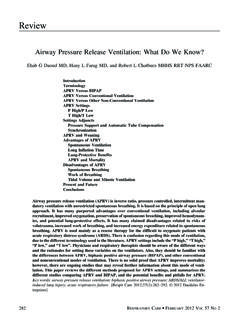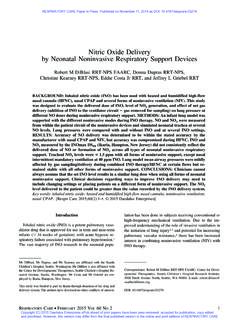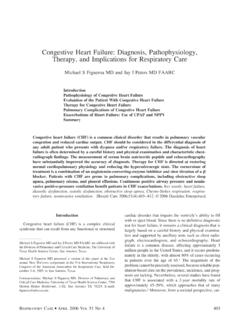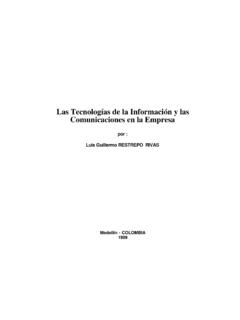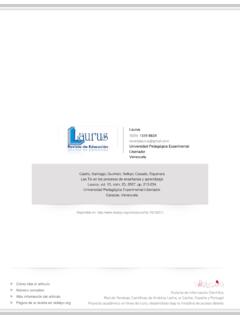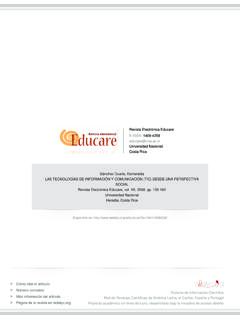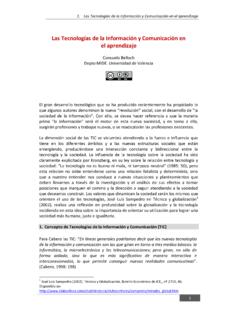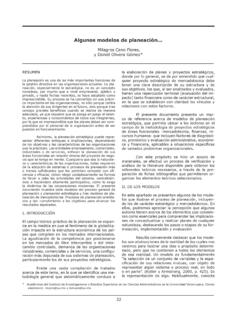Transcription of Tracheostomy Tubes
1 Tracheostomy TubesDean R Hess PhD RRT FAARC and Neila P Altobelli RRTI ntroductionAnatomy of the Tracheostomy TubeTracheostomy Tube MaterialTracheostomy Tube DimensionsExtra Length Tracheostomy TubesDual-Cannula Tracheostomy TubesFenestrated Tracheostomy TubesSubglottic Suction PortTracheostomy Tube CuffsStomal Maintenance DevicesChanging the Tracheostomy TubeDecannulationTracheostomy TeamsWard Versus ICUS peaking With a Tracheostomy TubeSpontaneously Breathing PatientsMechanically Ventilated PatientsSummaryTracheostomy Tubes are used to administer positive-pressure ventilation, to provide a patent air-way, and to provide access to the lower respiratory tract for airway clearance. They are availablein a variety of sizes and styles from several manufacturers.
2 The dimensions of Tracheostomy tubesare given by their inner diameter, outer diameter, length, and curvature. Differences in dimensionsbetween Tubes with the same inner diameter from different manufacturers are not commonlyappreciated but may have important clinical implications. Tracheostomy Tubes can be cuffed oruncuffed and may be fenestrated. Some Tracheostomy Tubes are designed with an inner cannula. Itis important for clinicians caring for patients with a Tracheostomy tube to appreciate the nuancesof various Tracheostomy tube designs and to select a tube that appropriately fits the patient. Theoptimal frequency of changing a chronic Tracheostomy tube is controversial. Specialized teams maybe useful in managing patients with a Tracheostomy .
3 Speech can be facilitated with a speaking valvein patients with a Tracheostomy tube who are breathing spontaneously. In mechanically ventilatedpatients with a Tracheostomy , a talking Tracheostomy tube, a deflated cuff technique with a speakingvalve, or a deflated cuff technique without a speaking valve can be used to facilitate : airway management; decannulation; fenestrated Tracheostomy tube; inner cannula; speakingvalve; Tracheostomy button; Tracheostomy team; Tracheostomy tube. [Respir Care 2014;59(6):956 973. 2014 Daedalus Enterprises]IntroductionTracheostomy Tubes are used to facilitate the adminis-tration of positive-pressure ventilation, to provide a patentairway in patients prone to upper airway obstruction, andto provide access to the lower respiratory tract for airwayclearance.
4 They are available in a variety of sizes ,outerdiameter, and any other distinguishing characteristics (per-cutaneous, extra length, fenestrated) are marked on the956 RESPIRATORYCARE JUNE2014 VOL59 NO6flange of the tube as a guide to the clinician. Some featuresare relatively standard among typical Tracheostomy Tubes (Fig. 1). It is important for clinicians caring for patientswith a Tracheostomy tube to understand these differencesand to use that understanding to select a tube that appro-priately fits the patient. This paper describes characteris-tics of Tracheostomy Tubes used in adult patients, speakingwith a Tracheostomy , and issues related to management ofthe Tracheostomy . It also covers issues related to speech inpatients with a Tracheostomy .
5 This paper updates paperspublished previously in RESPIRATORYCARE related to ,2 Anatomy of the Tracheostomy TubeTracheostomy Tube MaterialMetal Tubes are constructed of silver or stainless are not used commonly due to expense, rigid con-struction, and lack of a cuff and a 15-mm connector toattach a ventilator. A smooth rounded-tip obturator passedthrough the lumen of the Tracheostomy tube facilitates in-sertion of the tube by displacing rather than coring tissues;it is removed once the tube is in place. Metal is durable,inhibits bacteria growth, does not react with tissues, resistsbiofilm formation, is easy to clean, and can be sterilizedwith heat or most commonly used Tracheostomy Tubes are madefrom polyvinyl chloride (PVC), silicone, or softens at body temperature, conforming to patientanatomy and centering the tube in the trachea.
6 Silicone isnaturally soft and unaffected by temperature, resists colo-nization and biofilm buildup, and can be sterilized. Sometracheostomy Tubes are packaged with a tracheal wedge,which facilitates removal of the ventilator circuit whileminimizing the risk of dislodgement of the tracheostomytube. Like the metal tube, an obturator facilitates insertionof the Tube DimensionsThe dimensions of Tracheostomy Tubes are given by theirinner diameter, outer diameter, length, and curvature. Thesizes of some Tubes are given by Jackson size, which wasdeveloped for metal Tubes and refers to the length andtaper of the outer diameter. These Tubes have a gradualtaper from the proximal to the distal tip. The Jacksonsizing system is still used for most Shiley dual-cannulatracheostomy Tubes (Table 1), but the International Orga-nization for Standardization (ISO) method of sizing asdetermined by the inner diameter of the outer cannula at itssmallest dimension is used for most other Tubes .
7 For dual-cannula Tubes , the diameter of the inner cannula is thefunctional inner diameter. The outer diameter is the largestdiameter of the outer Tubes that might at first seem similar mayin fact be quite different in their dimensions (Fig. 2). Whenselecting a Tracheostomy tube, the inner diameter, outerdiameter, and length must be considered. If the inner di-ameter is too small, it will increase the resistance throughthe tube and make airway clearance more difficult. Asmaller inner diameter may also result in a smaller outerdiameter, which increases the cuff pressure required toThe authors are affiliated with the Respiratory Care Department, Mas-sachusetts General Hospital, Boston, Massachusetts. Dr Hess is also af-filiated with the Department of Anesthesia, Harvard Medical School,Boston, Hess presented this paper at the 52nd RESPIRATORYCAREJ ournalConference, Adult Artificial Airways and Airway Adjuncts held June14 and 15, 2013, in St Petersburg, Hess discloses relationships with Philips Respironics, Pari, Covidien,Maquet, Merck, and Bayer.
8 Ms Altobelli has no relationships to Hess and Altobelli are co-first : Dean Hess PhD RRT FAARC, Respiratory Care, Elli-son 401, Massachusetts General Hospital, Boston, MA 02114. 1. Components of a standard Tracheostomy 1. Jackson Tracheostomy Tube SizeJackson SizeInner Diameter (mm)OuterDiameter (mm)With InnerCannulaWithout inner diameter of the outer cannula is for the narrowest portion of the JUNE2014 VOL59 NO6957create a seal in the trachea. If the outer diameter is toolarge, the leak with the cuff deflated will be decreased, andthis will affect the ability to use the upper airway with cuffdeflation for speech. A tube with a larger outer diameterwill also be more difficult to pass through the stoma. A10-mm outer diameter tube is usually appropriate for adultwomen, and an 11-mm outer diameter tube is usually ap-propriate for adult men as an initial Tracheostomy tubesize.
9 A difference in Tracheostomy tube length betweentubes with the same inner diameter but from different man-ufacturers is not commonly appreciated (Table 2), and canhave important clinical Tubes are angled or curved (Fig. 3), afeature that can be used to improve the fit of the tube in thetrachea. The shape of the tube should conform as closelyas possible to the anatomy of the airway. Because thetrachea is essentially straight, the curved tube may notconform to the shape of the trachea, potentially allowingfor compression of the membranous part of the trachea,while the tip may traumatize the anterior portion. Angledtracheostomy Tubes have a curved portion and a straightportion. They enter the trachea at a less acute angle andmay exert less pressure at the stoma.
10 Because the portionof the tube that extends into the trachea is straight andconforms more closely to the natural anatomy of the air-way, the angled tube may be better centered in the tracheaand exert less pressure along the tracheal in vivo and in vitro dimensions, Mallick et al3reported that standard length Tracheostomy Tubes are tooshort for the typical critically ill patient. They recommendthat both the stomal and intratracheal lengths be madelonger by 1 cm and that Tubes should be redesigned to anangle of 110 120 to allow optimal tracheal Tracheostomy Tubes have a small discreteflange and are used in patients with a laryngectomy orsleep apnea. Percutaneous Tracheostomy Tubes have a ta-pered distal tip, a low-profile cuff designed to reduce in-sertion force, and an inverted cuff shoulder for easier Length Tracheostomy TubesIf the Tracheostomy tube is too short, the distal end canobstruct against the posterior tracheal wall (Fig.)
